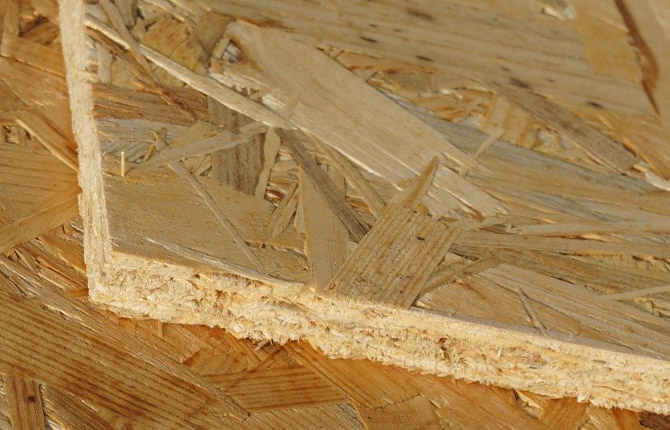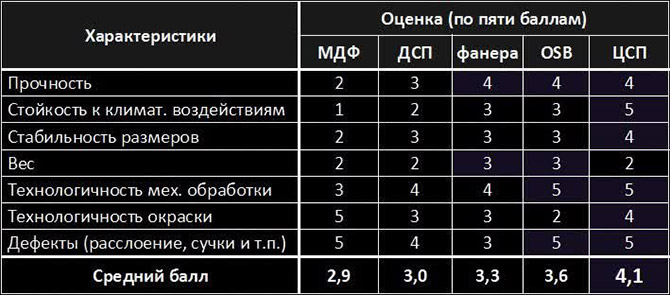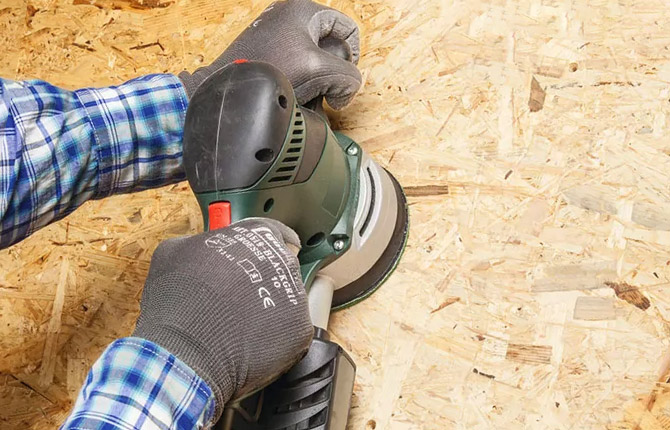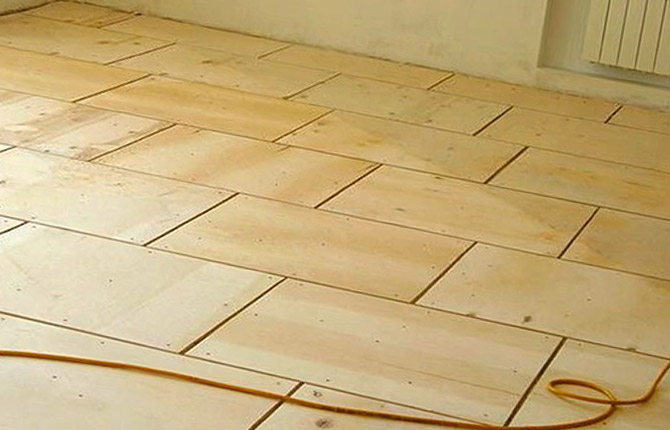What is better to choose plywood or OSB for the floor: comparison, advantages and disadvantages
Repairing a floor in a house or apartment is not only about selecting floor coverings, baseboard adhesives, calculating consumption and drawing up estimates. This is also the agony of choosing a lining material. The way a modern floor is designed is that the base for it is usually plywood or OSB. There is no way without lining material; today this is the best solution for any type of housing.
The content of the article:
General characteristics of OSB
Often on the slabs or on the price tags you can find another name for the material - OSB. It is the phonetic twin of the English abbreviation OSB. In the documents you can find the full name - “oriented strand board”. Both options are used in everyday life, OSB and OSB - “oriented strand board”.
Structurally, OSB is a thin slab or panel (up to 20 mm), consisting mainly of wide and long chips. It is generally accepted that this is the main difference between OSB and its closest competitor, chipboard (chipboard).
OSB technology was developed in Canada and the USA to replace toxic chipboard, so the method of making the board is different:
- Large shavings of coniferous trees are soaked in an aqueous solution of hydrogen peroxide, heated to 150℃ at a pressure of up to 40 Bar.
- The raw materials are kept for some time, after which the pressure is sharply released. The water on the surface of the chips boils explosively and simultaneously destroys certain fiber structures. Hemicelluloses are released from the cells, which serve as a binder.
- The material is dried at 100-120℃, treated with a preservative, wax and paraffin are added and pressed into large sheets.
- A mixture of hemicelluloses, wax and paraffin melts under pressure, filling the pores and air spaces between the wood fibers. The result is a rigid and solid structure.
So dense that if you knock on the OSB, the sound will be ringing, like bog oak or bakelite plastic, which indicates the rigid structure of the slab. If you knock on the chipboard, you will hear that the material is porous and soft.
The main advantage of OSB is that the original material practically does not contain toxic formaldehydes, like chipboard or plywood sheets. Sometimes this argument becomes the main one in cases where you need to make a decision - which is better for the floor - plywood or OSB.
You can compare shavings from cutting OSB, plywood and chipboard. With OSB it is fine, like powdered gypsum, and the smell is more like spruce. Plywood and chipboard shavings strongly smell of phenol-formaldehyde resin.
The material turned out to be in demand, but expensive to produce. Until Chinese enterprises started producing OSB. Instead of special preparation, the same phenol-formaldehyde or even isocyanate resin was added to the raw material (so that there was no smell) and pressed like regular chipboard. This is how new brands of OSB appeared, some of which are not recommended for indoor use.
Characteristics of OSB
In addition to the classic OSB-1, boards of the OSB-2, OSB-3, OSB-4 brands are produced. The materials differ from each other in water absorption, strength and resistance to bending load.
If you are looking for a material for a subfloor, the more important characteristics will be the vapor permeability and moisture resistance of the base. OSB-1 withstands contact with moisture the worst; in one day the material can absorb up to 25% of moisture. Even in a dry state, upon contact with water vapor, OSB swells and deforms.Therefore, it is recommended to store the material in a dry and heated room. Laying OSB-1 in the base under linoleum is the same as leaving an old wooden floor, the problems will be the same.
OSB 2,3,4 also absorb water from 20% to 12%, respectively. The higher the resistance of OSB to water, the more phenol-formaldehyde resin and paraffin it contains. OSB-2 can also be used for flooring, OSB-3 and OSB-4 are building materials for use outside residential premises. You can use it to make good formwork, roof lining, or lay the floor on a balcony.
General characteristics of plywood
The demand for plywood sheets made from spruce or birch veneer is higher than that of OSB. Plywood is actively used in low-rise home construction and even in the manufacture of furniture. Not because it, as a material, is better than OSB, but rather due to habit. It has been produced for decades in huge volumes, using a simple technology of gluing veneer into a multilayer package using phenol-formaldehyde resin.
Therefore, plywood is 20-25% of a polymer made of phenol and formaldehyde, which, on the one hand, gives the material high strength, but at the same time becomes a source of a specific odor and toxic fumes. On the other hand, if you choose what to lay on a plank floor - plywood or OSB - then a plywood sheet may be a better solution, since formaldehyde vapor often serves as a kind of preservative for floorboards.
The following grades of plywood are available for sale:
- FSF – increased moisture resistance. Can be laid as a base for flooring in unheated or irregularly heated rooms. Upon contact with water, it swells and delaminates.
- FOF – plywood for industrial construction.Withstands contact with aqueous emulsions, coolants and greases. It is better not to use it for flooring in rooms where there are people. As a last resort, you can hem the floor on the terrace and cover the thermal insulation on the roof.
- FC is a material in which veneers are glued together with a urea binder. It is classified as conditionally environmentally friendly.
- FKM is a modification of FK with additional surface gluing with melamine compositions. The plywood surface becomes more wear-resistant. Can be used as a temporary substitute for a full wooden floor.
- FBA - albumin-casein composition (a variant of synthetic casein glue) is used for gluing plywood.
- FB – bakelite plywood, waterproof. Can be used as a floor on an unglazed balcony, on an open veranda, for any construction, but not inside residential premises.
FB brand material can be used to level the base under a cement-sand screed, under tiles or self-leveling floors. This type of plywood has a low coefficient of expansion, high rigidity and strength making it indispensable in building structures.
For living rooms, it is best to choose FC or FKM - it is relatively safe in terms of the level of release of free phenol. But for floors of different designs it is better to use different brands of material. Moreover, safety is not considered the most important among the selection criteria. Plywood is almost always covered with an additional coating, so the amount of phenol-formaldehyde emission fades into the background.
In addition to the brand, you will need to take into account the grade of the material. The best quality is “E” or the highest grade. It has no surface defects and the highest price.The rest of the plywood is divided into 4 grades depending on the number and size of defective spots.
Use plywood sheet premium grade for laying on the floor does not make sense for economic reasons. Such material is expensive and is used mainly for the manufacture of furniture, parts for industrial installations and transport.
Grades 1-2 are inferior in appearance to the same OSB, so the slab is used only as a rough base. It’s better not to even plan the rest for finishing inside residential premises. Their toxicity is approximately three times higher than that of the first grade.
This is useful! Engineered board or laminate: what is better to choose for floor construction.
Options for comparing materials
Sheets of plywood and OSB can differ greatly in strength, durability, and resistance to alternating loads. In order for the comparison to be correct, it is necessary to take into account the amount of damage, effective thickness, and level of surface protection. OSB is a material without defects and has a homogeneous structure. Plywood sheets almost always have defects in the inner layers, but their effective thickness and strength are higher than those of OSB.
For the subfloor, OSB and plywood sheets with a thickness of 12-16 mm are used.
Environmental friendliness
Comparing 2 types of bases, plywood or OSB, in terms of safety conditions makes sense for materials that are similar in class.
The best brands of phenol-free OSB of the classical scheme are produced mainly in Norway, the USA and Canada. The environmental certificate indicates E0, the yield of phenol and formaldehyde from the material is zero.
The CIS countries, part of Eastern Europe, Turkey and China produce environmentally friendly OSB boards with a phenol and formaldehyde output of 2-3 mg per 100 g of material.For so-called waterproof OSB, the yield of formaldehyde per 100 g of pressed mass reaches 10 mg and even 30 mg. These are OSB construction grades and it is prohibited to use them inside residential premises.
Plywood is inferior to OSB in terms of environmental safety criteria. Again, there are premium brands of plywood class E0. The material is produced without the use of phenol-formaldehyde resins, so the yield of formaldehyde and phenol is zero. The cost of such plywood is approximately 3.5 times higher than that of class E1 material.
The most common material used for lining walls and floors indoors is plywood sheets of class E1 and E2. The formaldehyde content is respectively up to 10 mg and up to 30 mg per 100 g of pressed veneer. E1 plywood can be laid on the floor as a rough base. Even without coverage. E2 plywood is used for utility or residential premises; it can be used in tandem with subsequent additional finishing with gas-tight materials, such as linoleum.
E3 and E4 plywood cannot be used in private households. Can be used as formwork for concreting sites and small structures.
terms of Use
OSB is inferior to plywood in strength, resistance to moisture, and ability to withstand abrasive loads. If we compare 2 materials of the same class, then in terms of mechanical characteristics, sheet plywood with a thickness of 10 mm corresponds to the capabilities of OSB with a thickness of 16-18 mm. And in some cases - all 20 mm.
If you need to sew a rough base onto joists, it is better to use plywood sheets. OSB in such conditions (even double thickness) will not withstand bending loads. The material is tough but fragile.First of all, the places where the fasteners are screwed in will be destroyed.
Plywood floors, as well as any reinforcing or leveling coatings based on plywood, are more durable. They easily withstand difficult operating conditions.
A plywood sheet with a polished surface made of birch veneer of any brand (for example, FK) can withstand the abrasive load of average intensity from people's shoes for 3 years. We are talking about a dry and ventilated room. A floor covered with OSB-2 sheets will last 1.5-2 years at best. OSB coating – 3 years. In terms of wear resistance, formaldehyde and phenol content, oriented strand board will be approximately on the same level as plywood.
For a dry, heated and well-ventilated room, OSB will be a better option than plywood due to its lower phenol and formaldehyde content, as well as the low cost of the material. OSB is cheaper than plywood sheet.
The only exception is heated floors. It would seem that OSB has a more porous structure, good vapor permeability, and low thermal conductivity. This type of flooring should be more comfortable than a plywood floor. In fact, under constant heating conditions, OSB quickly degrades. The slab loses any remaining moisture and changes its structure, causing the material to crumble into pieces and chips over time.
For heated floors, birch plywood (not pine) of class E1 is used.
Care
Plywood and OSB are difficult to use. OSB, even when laminated with melamine film, absorbs moisture well, collects fine dust, water condensation and even sand.Therefore, if the subfloor made of oriented strand boards is not immediately covered with flooring, linoleum or laminate immediately after installation, then after a few months wear tracks from shoes will become visible on it.
And after another six months, the wear and tear on the “bare” floor will become so severe that it will no longer be possible to lay linoleum. It is necessary to additionally sew on a fiberboard covering to hide and level out worn areas. Any attempts to clean OSB floors end in nothing.
Birch and pine veneer are more resistant to contamination and contact with moisture, and if you do not leave puddles of water on the floor, the plywood can last up to a year without a floor covering.
The only disadvantage of a rough base made of safe plywood can be considered the high coefficient of thermal expansion. Therefore, the floor itself is usually assembled from small square blanks, between which a gap is left to compensate for the expansion of the material.
Durability
The surface of OSB is always rough and porous. Moreover, the shavings from which the board is pressed have low mechanical strength when compared with veneer. If handled carelessly, OSB can be easily damaged if you try to drag heavy objects - a sofa, washing machine or refrigerator - across the subfloor.
You can move any household equipment on a plywood floor, even without protective impregnation. If scratches or dirty spots appear on the plywood, they can be easily removed with a fine-grain sander.
On the one hand, the high porosity of the OSB surface is a plus, especially if it needs to be glued to mastic or painted. On the other hand, the absorbency of OSB is so great that any attempts to apply varnish, drying oil, or even PVA to OSB do not give the required result.Moreover, if there is too much water in the impregnating mixture, then all of it will remain inside the OSB.
Therefore, a protective coating is applied to OSB in 2 stages. First, apply a thin layer of acrylic varnish or any deep penetration primer with a roller. The next step is to paint the subfloor with oil paint or treat it with an emulsion of a mixture of PVA and water. After drying, a smooth film is formed that well protects the material from moisture and dirt.
The advantage of plywood is that it can withstand any treatment - from drying oil to polyurethane varnish. In this case, the wear resistance of the surface increases. Any floor covering, even parquet, can be laid on a plywood floor.
Installation method
There is one fundamental difference between plywood sheet and OSB. Plywood of any quality, due to its layered structure, has the ability to deform and adapt under load without destruction. OSB is more like monolithic polycarbonate. With a small load, the slab allows deflection, but as soon as the deflection value is slightly exceeded, cracks appear and the material begins to delaminate.
Therefore, OSB is fixed in 2 ways:
- Stick on paint or elastic mastic.
- Self-tapping screws with rubber bushings are used.
In the first case, OSB can be laid directly on a pre-milled floor. The surface is initially primed, dried, a layer of oil paint is applied and the slabs are laid.
Next, you need to lay out a dozen heavy objects on the floor surface. They are placed on slabs so that all the sheets lie approximately in the same plane. After the paint has dried, the weight is removed, the joints and seams are cleaned with a grinder.
Sheets of plywood are laid in a similar way, but mastic or glue is used instead of paint.To fix the plywood blank on the plank floor, use ordinary self-tapping screws. Wrap several pieces along the joints. Before wrapping the fasteners into plywood, you need to drill a hole with a diameter slightly smaller than the screw itself. Otherwise, the material may split.
Dowels can be used to fasten OSB or plywood to a concrete surface if the thickness of the floor allows. Pre-drill holes in the concrete and hammer in pine or oak plugs. If a fresh screed is being made for laying OSB or plywood, then instead of plugs, a couple of wooden blocks are placed in the concrete.
As a material for a rough base, plywood or OSB can be considered the best solution. All that is required is to correctly cut the sheets and lay them taking into account the characteristics of plywood sheets or particle boards.
Tell us about your experience using plywood or OSB for flooring in your home. How successful was the choice and what disadvantages can be noted in each material? Save the article to your bookmarks so as not to lose useful information.















OSB is laid out on a solid base, it needs to be glued to concrete, it is better to use resin mastic then there will be no demolition. OSB stands where the plywood will lead. Moisture is plywood’s worst enemy, but OSB can withstand it. You just need to paint it, otherwise it will rot.
I stuffed plywood onto the joists, I don’t know the brand, I bought the first one I came across. This is an ideal option for filing beams; the floor does not creak, and the joists have become much stiffer. I tried the same thing with OSB in the kitchen - in my opinion it was unsuccessful, there was no effect.